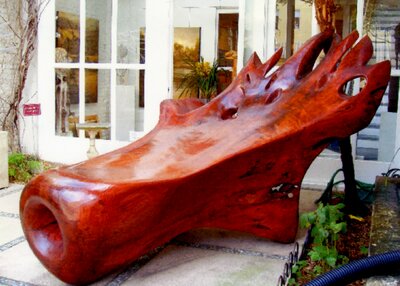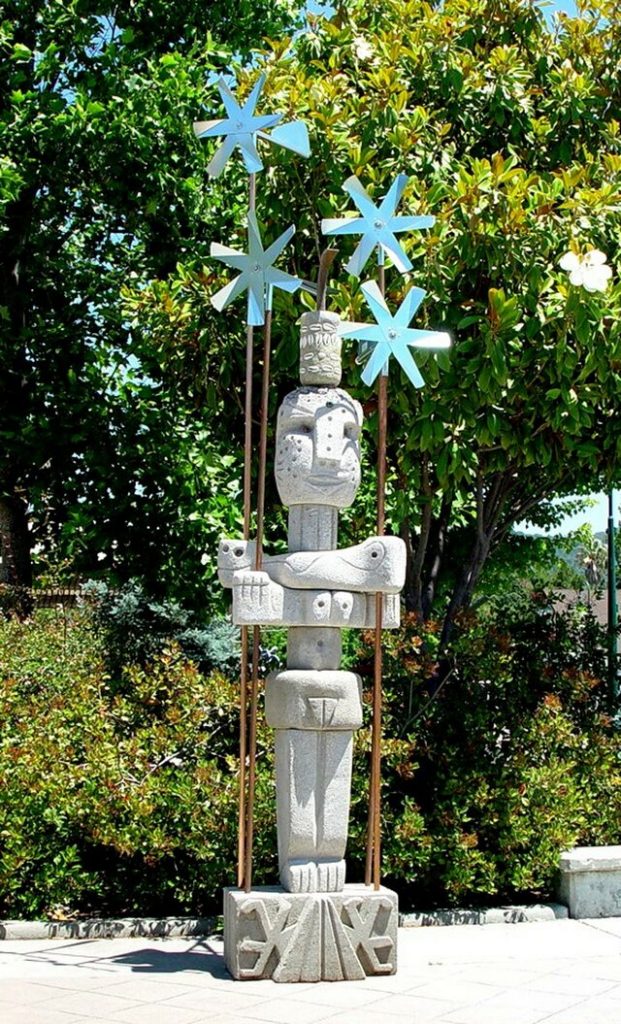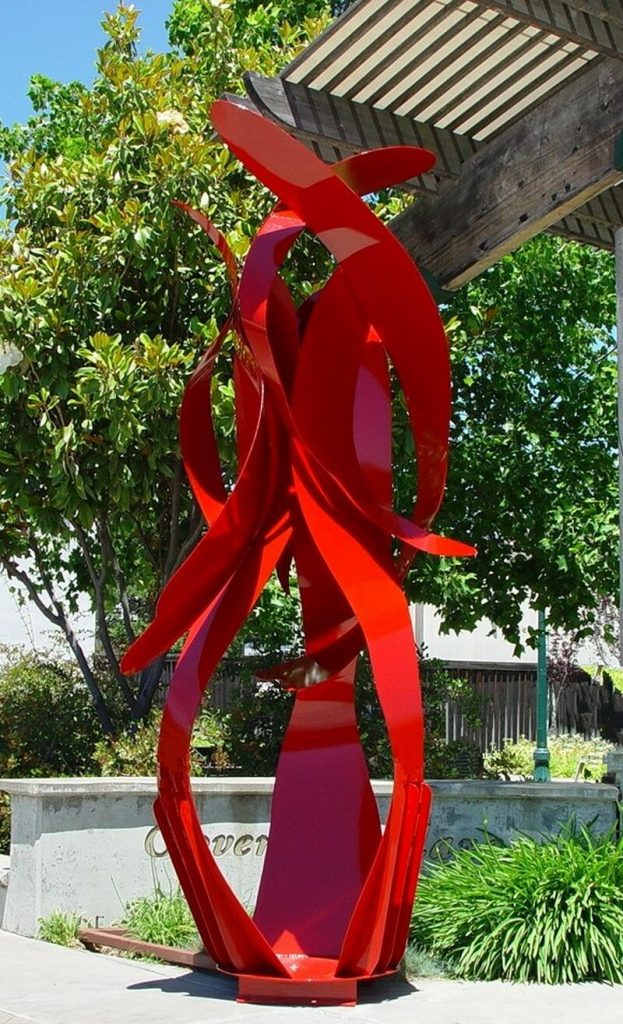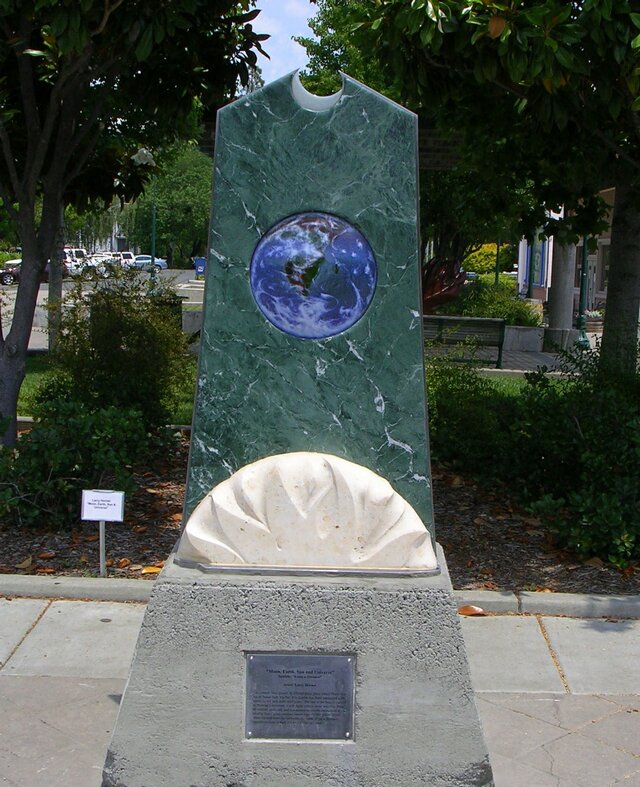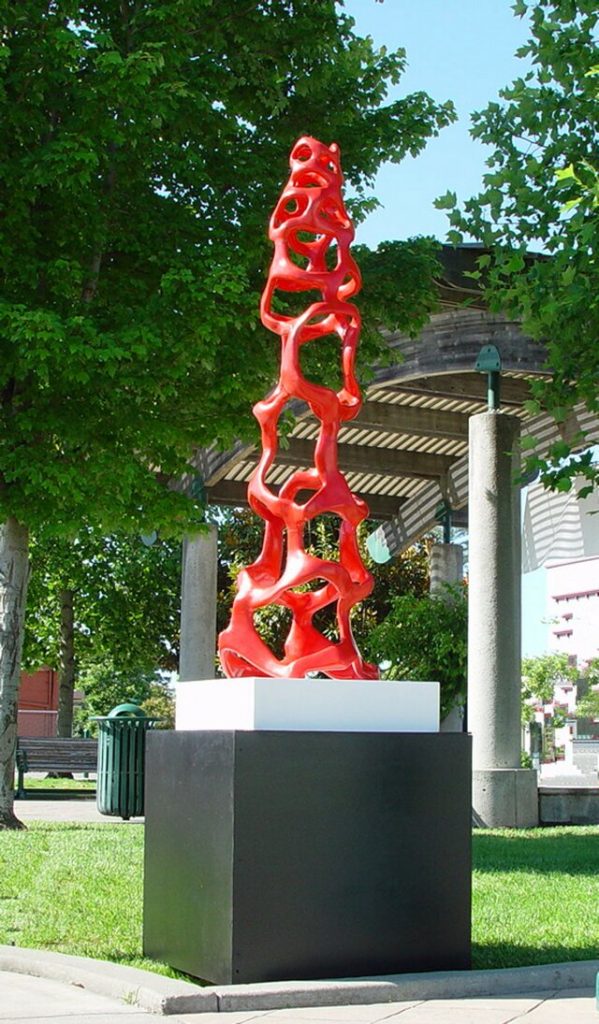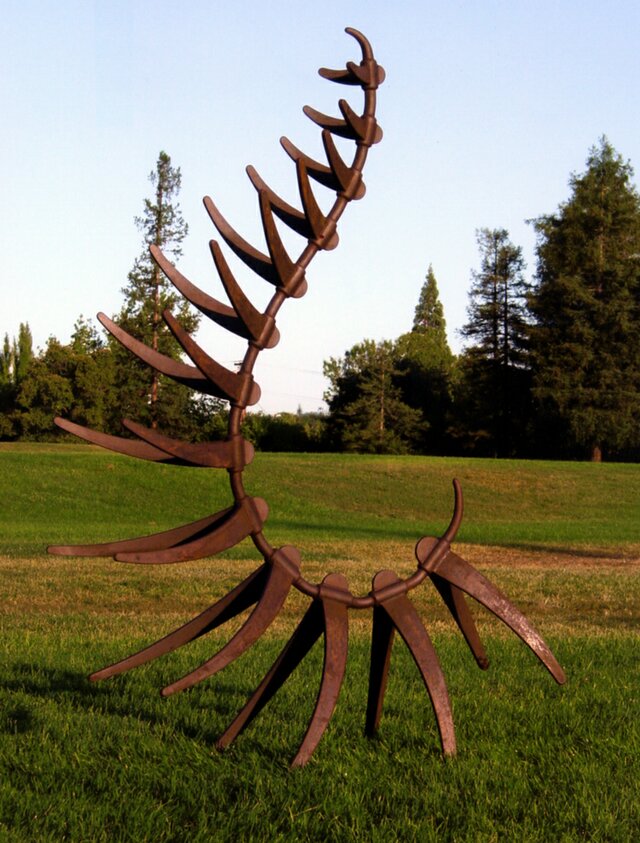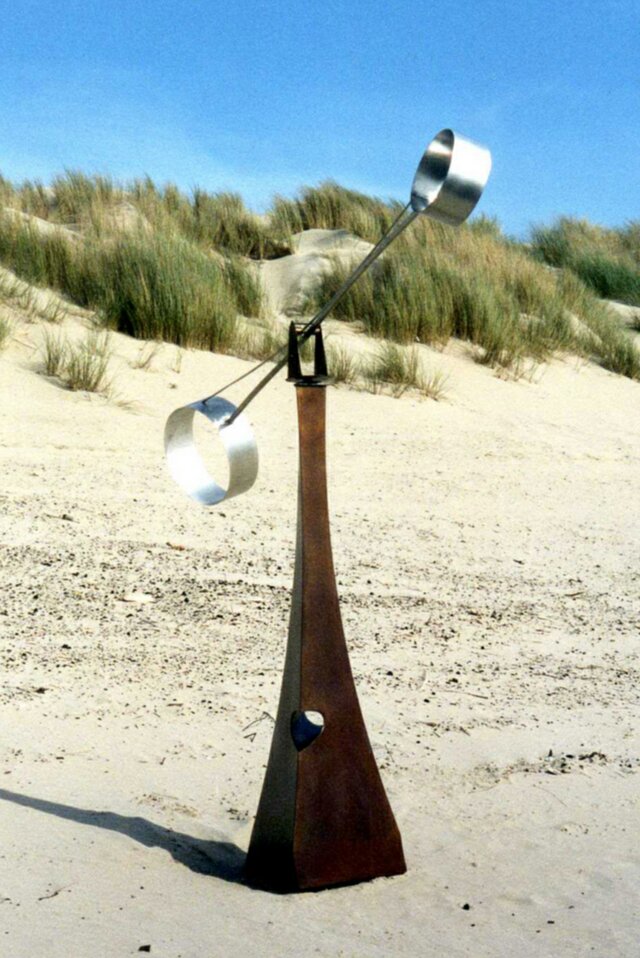2008 marks the 6th year of celebrating public art with the Annual Cloverdale Sculpture Exhibit. The exhibit enlivens our plaza each year for the benefit of the local community and those visiting our town, while also contributing to our reputation as an arts destination in Sonoma County. The Cloverdale Arts Alliance is honored to assume management of this important program in 2008.
A panel of 3 judges selected “Making Space for the Future” by Gale Wagner as “Best of Show” and presented him with a cash prize at the opening reception on June 7th. “Posing Kinetic” by Mark Oldland was awarded “Honorable Mention”.
3-D Eddy
Zen Tower
3D-Edddy is passionate about “junk” – the way we see it, what value can be found in it, and what we do with it. His work “Zen Tower”, currently on exhibit in our plaza this summer, is an example of what he calls “junk art”. “I use that term to educate the public about how valuable discarded items and junk really are,” he told us. “There are so many ready-made shapes and materials to use. The age adds a beauty and wisdom to the sculpture.”
“Zen Tower” is a found-object wood sculpture, a very spontaneous art form in which Edddy assembles odd-shaped pieces of wood together with nails, wire or “whatever”, using junk accents for character, humor, and design. It opens a channel to new ways of looking and creating. “Zen Tower” was created by staking antique wooden mock-ups of machine parts from now-defunct Rietz Manufacturing, a San Francisco-based company founded by Carl Rietz, an associate of Thomas Edison and Luther Burbank.
“I create with what’s at hand,” he said. “In the late 70’s and early 80’s, due to a lack of art education funding in our schools, I began to provide art enrichment for my family. Being of modest means, I used household junk (ready- made discards), used lumber, and found objects to construct sculptures. We gathered these materials and waited for the objects to speak to us, telling us what they wanted to be.
Constructively, our present generation threatens to become inundated with the accumulation of junk, and as was the case of the impressionists venturing out of the old school academy of art, the “Now” generation must do something constructive with our present time. As the population increases, more and more junk accumulates, and thinking people find themselves identifying with this new condition. Therefore, Junk Art is putting the nearly impossible articles together to make new sense for communication in the reality of our times.”
Steven Brown
Recliner
Steven Brown’s Recliner, the large redwood piece featured in the 2008 Sculpture Exhibit in the plaza, is fast becoming a favorite for those young and old who love to interact with it. Steven’s wish is that the piece will hold the viewers’ interest from any side long enough for them to find their own favorite vantage point. Viewers seem to be quickly establishing that favorite vantage point – in more ways than one: the rich tones of the wood invite the viewer to reach out and touch – or more … indeed, some have been unable to resist the suggestion of the title.
The piece, weighing in at about 1500 lbs, was the most difficult of all the exhibits to situate, given its weight, heft, and need to be placed under the shade structure to weather the Cloverdale summer sun. Now firmly in-place for the summer, the viewers’ obvious enjoyment suggests it was well-worth the logistical challenge.
Steven Brown carved Recliner from an old growth redwood stump in 2006. He told us his designs are suggested to him by the stump, and he explained his process as follows: “Normally, I will look at a rough stump until the sculptural possibilities become apparent to me. The direction I take is suggested to me as I carve into the core and respond to the grain, rather than imposing a particular shape to conform to my idea”. He went on to elaborate “after considering the sculptural potential of a redwood stump, root or burl, I begin by roughing out the form with a chainsaw, then use sanders, rasps and chisels to finish. I follow the lead of the natural grain and structure – normally it’s a process of simplifying to the core. The pieces are finished with spar varnish or log oil to seal against the elements, and to hold the color of the redwood. On some pieces I use furniture glides on the underside so they’re easier to move on a floor or deck”.
Mary Fuller
La Diosa de Los Vientos
“La Diosa de Los Vientos” by Mary Fuller, 2007, strikes an imposing figure at the entrance to our plaza this summer. Wind goddess, one of a group of wind sculptures currently in progress by Fuller, has quickly established herself as a local favorite with her imposing ten-foot-high concrete façade and her wind-activated moving parts. She is made of carved concrete, copper pipes, and mole chasers. “The Greek wind deities were male, but why not female?” challenged Fuller. “Supposedly so talkative … maybe windy as well.”
“I have always felt alienated from Western European culture as a source of my art, and my sculpture has been very profoundly influenced by Pre-Columbian and African work. If my sculpture comes close to achieving the vitality, the strength, humor and humanity of the work of the unknown artists from those cultures, I shall be very proud, because they are my esthetic and artistic guides.” Fuller lived in Mexico for a year before settling into her Sonoma County home – “that was the first time I saw the real (Pre-Columbian) stuff. They were really good: such a perfection of line. I think it was the seriousness of it as art that really got to me,” she said.
Gerard Kirk Harris
Winsome
“Winsome”, by Gerard Kirk Harris, resides in splendor at the entrance to our plaza this summer. The elements are tall and slender, with gentle curves and colors that provide a graceful interplay between them. “Winsome” invites moving around it, and watching as colors and forms appear, interplay, and disappear behind each other, providing variety in the theme.
Harris stumbled upon his interest in visual and conceptual relationships, and the balances between the elements within a sculpture and with its environment, while arranging sticks on the ground. “When I placed them in a rigid, geometric pattern, my eye focused on the pattern, but when I moved them into a disorderly arrangement, I noticed a leaf among them. This leaf had always been there, but the first geometric pattern had been so strong I had overlooked it. It was the disorder that allowed the environment to enter into the design.”
“Winsome uses design principles similar to those used by a composer composing a piece of classical music,” Harris elaborated. “A composer uses notes, phrases and themes, as building blocks for a composition. These are varied, and placed in relationships with each other to create the overall composition. “Winsome” contains two similar but varied sections (phrases) in a relationship that allows them to visually interplay with one another, thus composing a sculptural theme analogous to a musical theme. I am currently working on plans for a sculptural symphony, with four movements, using the symphonic form developed by Franz Joseph Hayden.”
Douglas Heine
Spirit Dance II
“Spirit Dance II”, by Douglas Heine, graces the entrance to our plaza this summer. At the opening reception, one enthusiastic visitor described it for us: “with its big red dancing presence, it draws me into the square in a wonderfully fun and modern way”. Cloverdalians seem to agree as they continue to enjoy our Sixth Annual Sculpture exhibit, scheduled to remain in the plaza until October 1st.
When asked about his inspiration for Spirit Dance, Heine told us “we are encased in this bag of bones only that we as spirits, may recognize each other, perhaps just as we leave, for who knows where. We gather for one last dance, one last joyful act. This sculpture represents that dance of spirits”. The work consists of fabricated sheet steel, welded and then powder coated.
In discussing his work in general, Heine continued “the two areas of interest in my work are the figure, and harmony within abstract forms. I work in many materials – marble, steel, aluminum, fabricated bronze, and bronze casting. In my paintings and tapestries it is again the figure and the visual play of harmonics, both in form and color. It is also true that process intrigues me greatly. If I use the metaphor of listening to music, one day it’s the classics, the next day jazz. I have never felt the need to restrict myself to one form or another, any more than listening to one type of music. And in that constant, there is variable. Each design challenge has its particular set of restrictions and opportunities, leading me toward a solution that is unique and specific to location, aesthetic, material and spirit. If I am true to the beauty of form, that harmony remains constant, whether the music is classical or improvisational jazz.
Larry Horner
Moon, Earth, Sun & Universe
Local artist Larry Horner is displaying a brand new piece for us, “Moon, Earth, Sun & Universe” all summer long at the entrance to the plaza. A resident of Cloverdale for the last 6 years, he is a first -time exhibitor in the Annual Cloverdale Sculpture Exhibit. The exhibit will continue until October 1st.
“Moon, Earth, Sun & Universe” is a conceptual view of our world “from a distance.” The central ‘blue planet’ is a fused-glass piece which floats in a sea of Julian Jade Marble. The marble has been laminated with epoxy to 1/4 inch mild steel plate. The sun at the base is carved in Hadrian Limestone, a soft, light yellow stone which is about 80 million years old, and has numerous fossils – or “sunspots on the sun” if you will – throughout it. A smaller fused-glass crescent moon tops off this piece. Even when viewed from the backside, the earth (from a distance) appears to float in a dark sea we call our universe.
Horner has been an artist since he was a small child, and a fine arts major since 1983. For the last decade, he’s been focused primarily on his sculptures, mostly in stone and alabaster. He told us “I love 3-dimensional work and I prefer them to be natural, figurative, and/or abstract, with a touch of whimsy included. Lately I’ve been designing and working on several larger public art projects that incorporate stone, steel, glass and concrete. My focus as an artist is to be as prolific as time and money will allow.”
Shelby Kennedy
Someone Meditating
Click here to see details of the process for “Someone Meditating”
As we travel north on Cloverdale Boulevard this summer, we find ourselves approaching “Someone Meditating” by Shelby Kennedy, a large and arresting piece at the forefront of the plaza. This piece is a large bas-relief of individual heavy clay “bricks”, similar in size and format to adobe bricks. There are figurative and plant forms in high to medium relief. The piece is fired and partially glazed.
“I am focusing on what may be useful to me, and perhaps to other people”, Kennedy told us. “I want to portray simple things that might hold an emotive energy, and that may engender a wholesome or complete feeling. The main theme I seek to convey is the connection between the beauty of the natural world and our own human aspirations. To reconnect with our innate nature is a most satisfying matter”.
A bas-relief on such a sizable scale presents many logistical challenges, and Kennedy worked intensively for 3+ months to produce “Someone Meditating”. He employed a technique taught by Louis Katz in his 1992 video, “Traditional Tai Pottery”. First, with the aid of a mold, he produced the individual thick blocks of solid clay. These blocks were then set on a concrete floor to stiffen for a few days, to permit handling. Next, he placed the blocks on a heavy wooden easel and transferred a full size drawing onto them, using a spiked pattern roller and powered charcoal. Now he was ready to start the meticulous work of carving down the backgrounds with large wire loop tools, and modeling and enhancing the figure with wire loop and hardwood tools. Once the bas-relief was concluded in this way, the completed blocks were hollowed out in back to reduce weight, placed on a wire rack to dry, and then fired in a ceramic kiln. Kennedy crafted a heavy timber stand to hold the “bricks”, and a grid of iron rods that would sit in pre-made grooves in the “bricks” for stability. Finally, he assembled the piece over the course of 2 days onsite, at the Plaza.
Irwin Luckman
Suhrra
Completed in 2003, “Suhrra” by Irwin Luckman was as technically challenging as it is beautiful. This piece is made of fired ceramic finished with water-resistant acrylic. It is composed of six units, small enough to fit inside the available kiln, and light enough to be handled when moist. The units are pegged and fastened to each other, and mounted on a white base. Artist Irwin Luckman spent a year manifesting his vision, and the result is on display at the plaza, downtown Cloverdale, until October 1st.
Luckman told us that, as with most of his sculpture, “the focus of this piece is on the voids – their interaction with each other, their see-through overlapping, and their contrasts of scale. The abstract forms, both negative and positive, are intended to be aesthetically stimulating without representing recognizable shapes”.
Although “Suhrra” is conventional in scale, many of Luckman’s pieces are models of monumental sculpture, which call upon the viewer’s ability to imagine walking through and around the complex shapes. These pieces are intended to capture the aesthetic impact of grand architectural spaces, but without the restraints imposed by practical functional requirements. Proportionately sized human figures placed within them suggest the immense scale of the spaces which are envisioned.
David Mudgett
Vertebrate
Sixth Annual Cloverdale Sculpture exhibit “Vertebrate”, by David Mudgett, has established itself as a favorite among many within the Cloverdale community. With its primal shape and rich metallic tones, it invites the viewer to reach out and touch.
Although the skeletal form could have been inspired by many animate beings, Mudgett tells us it emerged from years of fishing. “Their skeletons became permanently burned into my psyche, as did the shape of the hook that had caught them. I originally merged these two impressions into a smaller indoor sculpture, which, over time, evolved into this larger version”. Vertebrate is formed and fabricated from mild steel.
Mudgett has been building things all his life. “Always encouraged to repair rather than replace, I became mechanically inclined at a very young age”, he explained. “I was born with an allergy to text, and filled my youth with the great outdoors. I have always gravitated towards shape, sound and movement”.
Mark Oldland
Posing Kinetic
Sculptor Mark Oldland won the coveted designation of Honorable Mention from judges Edwin Hamilton, Debra LeHane, and Steve Oliver at the opening of the 6th Annual Cloverdale Sculpture Exhibit with his wind-driven work, “Posing Kinetic”.
The piece is fast becoming a local favorite, with its unpredictable motion. This is right in line with Mark’s intent: he described his piece as “a wind-driven kinetic – I deliberately avoid vanes which move too predictably, so that when idle/static, people could easily guess what the vane will do once the breeze activates it again. Very light breeze activates this design. In 25-60 mph wind it goes into what I call “grazing mode”, its movement then reminding me of grazing beasts. With this behavior, it has the least exposure to the wind. Rotation ceases and only incremental lateral movement occurs. It can be a rather meditative experience to watch this thing perform”.
Cricket Seagull
Dave M
“Dave M”, by sculptor Cricket Seagull, is now well-entrenched in a complementary role to the Friday Night Live musicians in its pride of place, left of stage. The steel trumpet player, positioned in the act of taking a solo, is crouched in an effort to express the deepest emotion available that can be transmitted to the instrument. The exhaust pipes give a dancing-like quality to the piece. Friday Night Live performers have enjoyed having “DaveM” join their bands for the evening.
As a musician himself, Cricket often uses musicians as a subject for his work. He went on to clarify, “there is a universal element in music. Everyone worldwide experiences music. I like recycling exhaust pipes; the shapes are intriguing to me. The curves are very expressive and suggest a lot of movement. Using exhaust pipes to create musicians gives them movements, and shapes, that are hard to achieve in real life. This allows the imagination to run wild. Some of my favorite experiences with exhibiting my work are when people try to imitate what the sculptures are doing”.
Paul Van Lith
Votive Landscape
“Votive Landscape,” by Paul Van Lith, is a new piece completed especially for the Sixth Annual Cloverdale Sculpture Exhibit in our plaza this summer. In a reversal of our expectations, the figure is horizontal, and follows the planes and contours of the landscapes seen all around us, while the abstract elements of the base become the figures in those landscapes. As with much of the finest art, we are challenged to look around us in a new way.
“Votive Landscape” is formed from plaster, wood, stucco and concrete – “materials as old as some of my inspirations” Van Lith told us. “I have combined them here with the love I have for modern art. These materials are good at give and take. The rewards are wonderful but they exact a price.” He went on to explain – “with plaster, you have to see what you are doing and do it, as it quickly sets rock hard. Wood is alive and responds to the environment. Concrete is concrete, and it does what it wants to do. I try to make the accidents happen in my favor. Each piece, in some way, remembers the past, from the simple triangle or zigzag ornamentation which is present in almost all archaic cultures, to the primitive methods of positive mold making I employ to cast the concrete. The sculptures talk about what it can mean to be human, both past and present, seeing Praxiteles and Brancusi with the same eyes.”
Gale Wagner
Making Space for the Future
In his first-ever showing in Cloverdale, sculptor Gale Wagner scooped the Best of Show award at the opening reception June 7th with his piece “Making Space for the Future.” Judges Edwin Hamilton, Debra LeHane, and Steve Oliver deliberated long and hard in making their decision, and expressed enthusiasm for the overall high quality of the numerous works on exhibit.
Gale described his piece as a combination of his Flower Pot Series from the 1980’s and his Toy Series from the 1990’s. “Flower pots are to nurture, and the toys are to entertain the child in us all,” he explained. “The bronze egg is nested in the square branches, making reference to genetic engineering, as it becomes more relevant to our harsh environment for the generations yet to come.”
In discussing his inspiration, Wagner stated “Anything entering my mind may become that point of origin for sculpture to be born. To my mind, it could begin with a chunk of steel, a particular experience, a historical event, all things ….. as in a science project, the adventure develops a direction, builds its own momentum, and develops a life of its own. It is enhanced through respect and pure love of the materials and process. I love what I do and try to reach as many people as possible. I hope it arouses something within each and every viewer – curiosity, amusement, mystery…..”


